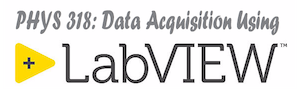We start out today with a module from LabVIEW Core 1 called Controlling Data Types that describes what type definitions are and how to create them. We will need this information in the context of creating type-defined enumerated constants. However, the module focuses on creating type-defined clusters. We have skipped the module on clusters for now so this may cause a little confusion. Just keep in mind that a cluster is a data type that allows you to group a number of items, that don’t have to be the same data type, into one object. An example we have already seen is an error cluster which contains a boolean, a numeric and a string. For the purpose of this module just focus on why type-definitions are important and useful, the difference between a standard and a strict type definition, and how to create and use a type definition.
Access LabVIEW Core 1 Course- Core 1: 10. Controlling Data Types
We have been making measurements of slowly varying signals all semester, but in this first module from the Measurement Fundamental series we will start taking a deeper dive on Measuring Voltage or Current. There is a great deal of information in this module that is important to us throughout the semester. You will learn about how the number of bits of an ADC effect the minimum change that can be detected in a measurement. There is also an in depth discussion of four different important types of signal conditioning: amplification, attenuation, filtering, and isolation.
Access Using NI-DAQmx Course- MF: 1. Measuring Voltage or Current
The following pages provide an additional point of view in our deep dive on using data acquisition to measure different signal types.
Today in class we will:
- review recent LabVIEW Core 1 topics such as enumerations, case structures, and type-definitions,
- discuss the LabVIEW: Environment badge exam,
- discuss fundamentals of data acquisition, different types of signals, and the information that can be measured from various signals, and
- work on the assignment A02 – Temperature Monitor.



